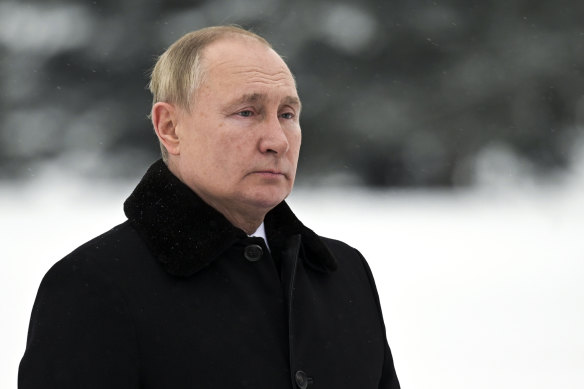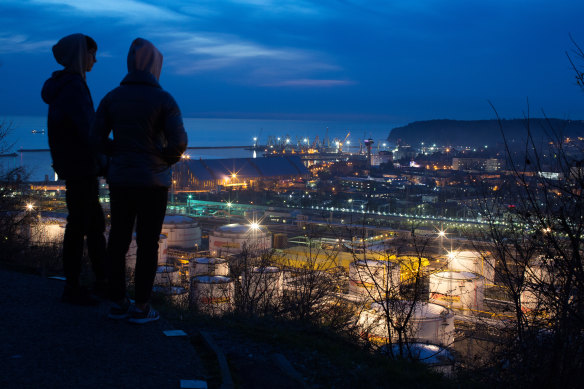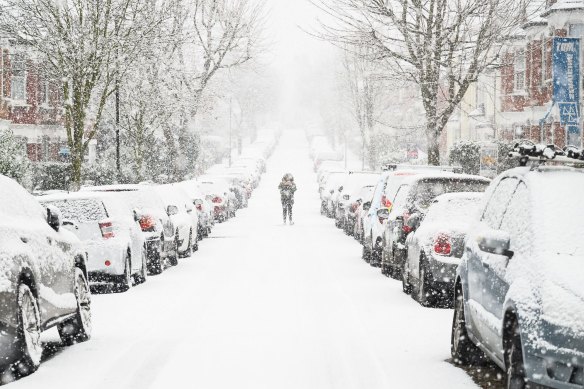This was published 2 years ago
Opinion
The West has escalated its attack on Putin’s war chest. Now it’s a waiting game
Stephen Bartholomeusz
Senior business columnistThe cap on the price of Russian oil came into effect on Monday. The multi-billion dollar question and the course of the war in Ukraine now hinge on how effective it will be.
The cap is only part of, and probably the lesser part of, the sanctions on Russian oil agreed by the Europeans, the G-7 and, yes, Australia. They’ve all agreed not to buy seaborne Russian oil, which means that about a quarter of the demand for that oil before it invaded Ukraine has evaporated.

The cap is designed to encourage Russia to keep producing oil while limiting how much revenue Moscow can make off it.Credit: AP
The concept of the cap was sponsored by the US which was concerned that European Union plans to impose an embargo on Russia’s oil, backed by the withdrawal of insurance and other financial services, would result in a big jump in global oil prices.
The cap, set at $US60 a barrel on Monday, is supposed to encourage Russia to keep producing and therefore keep a lid on the oil price while constraining the revenue it generates and therefore impacting its ability to finance the war in Ukraine.
While the cap has been set above the price at which Russia’s Urals product has been trading – recent sales to China, India and other Asian buyers have been around $US52 a barrel – the US is also hoping that those buyers that haven’t signed up to the sanctions will use the cap as leverage to negotiate larger discounts to global prices and push the prices Russia receives closer to its costs of production.
The cap will be subject to regular review and could be tightened if the participants conclude that it isn’t having the desired effect.
The bans on insurance have teeth because UK and European insurers dominate the insurance and reinsurance markets for shipping and Europe is the home for much of the world’s tankers.
While Russia has been busily building a “shadow” fleet of ageing tankers – it reportedly has acquired about 90 tankers of varying capacities – that is well under half the fleet of about 240 more modern and efficient tankers that carried Russian oil pre-invasion. It has also been offering its own insurance, although that might not be acceptable to some shipowners, ports or canal operators.
Russia’s response to the cap and embargo was predictable, with a Kremlin spokesman, Dmitry Peskov, saying it would not accept the cap and wouldn’t sell its oil to anyone that complied with it. Russia has said it would redirect its supply to “market-oriented” partners or simply reduce its production.
Acquiring and operating a tanker fleet and redirecting oil that used to be sold into Europe to more distant Asian markets – China and India have been the biggest buyers of Russian oil since the invasion, more than trebling their purchases – will, however, significantly increase Russia’s costs and reduce its net revenue from oil sales.
The initial response to the introduction of the cap and the embargo was a spike in the oil price from just under $US86 a barrel to just over $US88 a barrel.

The trajectory of oil prices – and the net revenue Russia can generate from inevitably lower oil sales – is going to be heavily influenced by the state of the global economy and the US and China in particular.Credit: Bloomberg
The price fell back to below $US83 a barrel, however, after stronger than expected service sector data in the US raised fears that the US Federal Reserve Board would have to continue to raise US interest rates more aggressively than financial markets had been factoring in.
The trajectory of oil prices – and the net revenue Russia can generate from inevitably lower oil sales – is going to be heavily influenced by the state of the global economy and the US and China in particular. Further aggressive rate hikes in the US could ensure a recession while China’s outlook is clouded by its confused response to COVID outbreaks.
China does appear to be relaxing its harsh zero-COVID approach after the recent highly unusual waves of protests in its major cities, even as fresh outbreaks are spreading. The outlook for its economy remains weak, which will limit is demand for oil even if the early indications of a significant change in COVID policies are borne out.
In the long term, Russia might be the biggest loser from its decision to invade Ukraine but the unpleasant aftershocks of the invasion will reverberate through global energy markets for years to come.
There was a lot of debate in the lead up to the decision to set the cap at $US60 a barrel. Some countries, like Poland, wanted to set it at $US30 a barrel to effectively decimate Russia’s oil revenues and economy and ability to fund the war. Others wanted a higher cap to ensure the oil kept flowing and therefore minimising the damage to already weak western economies.
How much damage the cap does to Russia, or the West, probably hinges on what OPEC does.
Members of the OPEC+ cartel (which includes Russia) decided at the weekend to maintain their current production quotas, which include the two million barrels a day reduction in output agreed in October, while they wait to see the impact of the embargo and price cap.
If OPEC were to cut production further the oil price would rise and the effectiveness of the cap and Russia’s responses to it would be tested.

Energy markets may never be the same.Credit: Getty
An increase in OPEC output might be unlikely (unless there is an unexpected surge in global economic activity) but if oil prices were to fall further then, assuming the $US25 to $US30 a barrel discount China and India have been able to obtain on Russian crude were to be maintained, Russia’s revenue would be severely crimped.
The lessons the Europeans have learned this year as Russia used their reliance on its energy against them will have lasting impacts on the energy market.
European Union economies have cut their demand for gas by about 25 per cent in response to/as a result of Russia’s throttling of gas sales into Europe and have, at significant cost and with a significant impact on LNG prices, been scrambling to source supplies from the international market while also curtailing demand.
The flow-on effects of that re-direction of Europe’s demand are being felt throughout the Asia Pacific, the biggest market for LNG, and has ignited a difficult debate about gas prices and supply even here in Australia.
Given that Europe isn’t going to resume its over-reliance on Russia gas even if the war in Ukraine eventually ends, that new demand for LNG will be a permanent feature of a market where the supply-demand equation is very tight, the lead times for new supply to be added are long and the cost of new supply is high. High gas prices won’t be a short-lived phenomenon.
Similarly, Europe will diversify its oil supply, which will have an impact, if not the overall demand for oil, then on the geography of supply and demand.
In the long term, Russia might be the biggest loser from its decision to invade Ukraine but the unpleasant aftershocks of the invasion will reverberate through global energy markets for years to come.
The Market Recap newsletter is a wrap of the day’s trading. Get it each weekday afternoon.